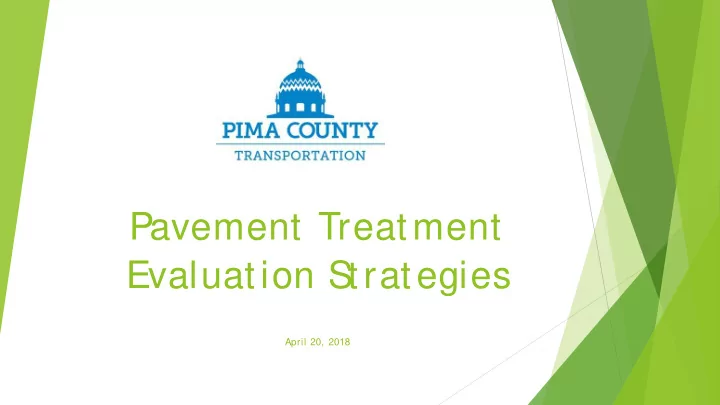

Pavement Treatment Evaluation S trategies April 20, 2018
Department Improvement plan: pavement elements Infrastructure and network management system Analysis-based focus Risk/ life-cycle-costing Return on Investment
Material Laboratory re-orientation Forensic statistical analysis from Network Management System Factors contributing to failure Factors contributing to longevity Materials research testing Pavement design
Flexible Pavement S tresses Flexible pavement stresses (force per area): Horizontal tensile strain (deformation) at bottom of AC layer Vertical compressive strain at top of subgrade S tiffness (not strength) is most important property for unbound materials in flexible pavements Resilient Modulus (M R ) S tiffness Preferred characterization of subgrade by AAS HTO in 1986 Definition: ratio of applied cyclic stress to recoverable (elastic) strain after repeated loading cycles Best evaluated in laboratory using a triaxial test
Currently adopted pavement design AASHTO 1993 ADOT R-value correlation issue Minimum local street standard (<1000 ADT) 2.5” S ingle Lift AC 4” AB 1.49 S tructural Number
Pavement design transition Moving toward AASHTOWare Pavement ME to better predict performance Materials mechanics Climate data Axle-load spectra Truck counts
Traditional pavement life cycle
P AS ER surface distress Block Cracking Excess Asphalt Fatigue cracking Longitudinal cracking Patching Raveling Rutting S hoving/ Pushing/ Corrugation Transverse cracking Oxidation
Pima County standard treatments Reconstruction (P AS ER 1-2) 2” Mill/ fill (P AS ER 1-4) 2” Overlay (P AS ER 4-5) Maj or seal coat (P AS ER 5-6) Chip-seal Micro-surface Micro-seal Minor seal coat (P AS ER 7-9) Fog seal
Factors affecting material behavior Base Native AB Cement/ lime treated Compaction increased from 95 to 96% Effective air voids decreased from 4 to 3.5% Voids in Mineral Aggregate increased from 15 to 16% Recycled asphalt pavement prohibited for local/ collector streets Binder grade (penetration, viscosity) Binder modifiers (polymers) Crumb rubber (asphalt-rubber asphaltic concrete-ARAC) Terminal Blend (terminal blended rubberized asphalt-TR)
Alternative treatments Concrete treated base Chip seals Roller compacted concrete (RCC) Polymer-modified AC (ARAC/ TR) Thin asphalt concrete overlays Aramid fibers Geofabric & S tress Absorbing Membrane Interlayers S urface sealers HA5 (high density mineral bond) S ealMaster Liquid Road (polymer-modified, fiber reinforced asphalt emulsion coating)
Pavement Testing Plan Obj ective: test different materials of differing initial cost to evaluate life-cycle ROI Test section: S an Joaquin Road from Old Aj o Highway to Milky Way Drive Total proj ect length 4.3 miles ADT 2100 vehicles per day Existing pavement 2” chip seal (multi-layer) on subgrade S ubgrade R-value 30 – 51 P AS ER Rating 3 Number of test sections 13 Length of test sections 1000 feet
Test plan treatments 1” Green asphalt over existing 1. 1 ¼” overlay of existing with P AG 3 Terminal Blend 2. 2” overlay of existing (P AG 2 mix) 3. 2” overlay of existing (P AG 2 mix with fiber) 4. 2” overlay of existing (P AG 2 mix terminal blend) 5. Pulverize 5” and compact with cape seal (chip seal plus slurry seal) 6. Pulverize 5” and compact with chip seal 7. Pulverize 5” and compact with cement (300 psi) and chip seal 8. Pulverize 5” and compact with cement (500 psi) and chip seal 9. 10. 6” roller compacted concrete 11. Double chip seal over existing 12. Rubberized chip seal over existing 13. 2” mill and fill (P AG 2 mix)
Test plan layout & soil borings
Test evaluation Evaluation at regular intervals (6 months, 1 year, 2 years… ) Localized soil tests & drainage crossings will be identified and correlated to pavement condition evaluation P AG/ COT Automated Road Analyzer van Observations Cracking Rutting Oxidation S urface wear/ roughness Materials testing Additional lab tests may be used to evaluate cause/ effect of visual observations or for purposes of proj ecting longevity Return on Investment (ROI) Treatment-specific ROI curves will be developed based on data from each evaluation interval to rank treatment benefit-cost proj ection Treatment-specific curves will be correlated against national research curves for that treatment, to infer longer term performance from shorter observation periods
Next steps S olicit TAC subcommittee feedback and recommendations Evaluate testing protocols based on feedback Evaluate pavement standards based on feedback Provide a materials use and testing summary report based on feedback Need for follow-up pavement subcommittee meeting?
Recommend
More recommend